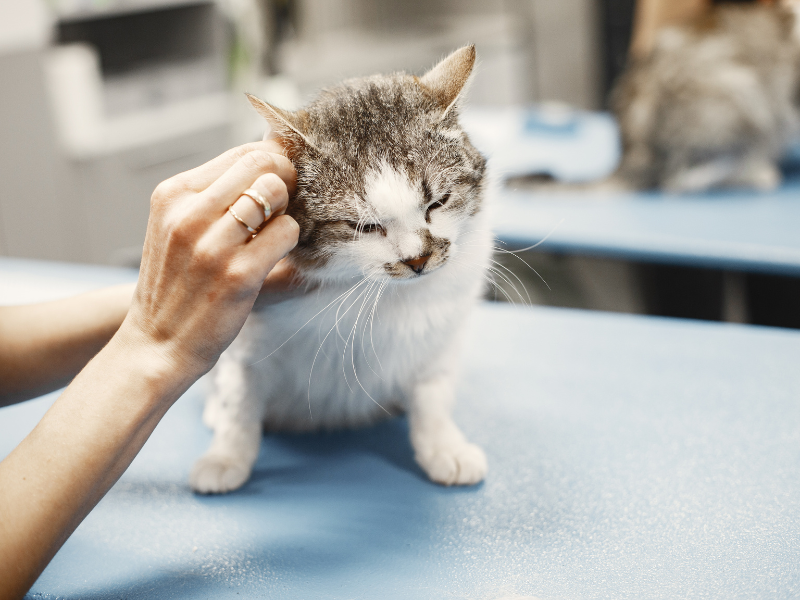How to Spot an Ear Infection
Cats get ear infections just like people. It doesn’t happen often, but when it does, your cat will need to see a vet. If left untreated, ear infections can inhibit your cat’s balance or even lead to deafness.
Knowing the signs of an ear infection can save you precious time (and potentially avoid a costly trip to the vet if it’s not an ear infection). Let’s explore what to look for.
Signs Your Cat Has an Ear Infection
Just one of these signs might not indicate an ear infection. But if you notice several of these symptoms at once or if any of these symptoms don’t go away, it might be time to get a diagnosis. Look for the following signs of a cat ear infection.
1. Redness Inside the Ear
Even if you’re not a vet, you can tell if your cat’s ear seems redder than usual. Redness is a sign of an ear infection, along with swelling and inflammation. This is your cat’s natural immune response to the infection and can be an early indicator that something is wrong.
You don’t need special tools to detect redness or swelling, as these affect the visible part of the ear. Make sure to respond to this symptom quickly, as chronic infections can make the ear skin scabby or thick.
2. A Loss of Balance
Your cat’s inner ear helps them balance. If the infection spreads to the middle or inner ear, your cat might have trouble walking normally. They might seem disoriented, uncoordinated, or unable to walk with a purpose. They might also be at risk of falling, especially if they are used to climbing.
3. Sensitivity or Pain
Infections can make your cat’s ears sensitive. Even if they like it when you pet their ears, they might shy away or get loud when you try to touch them. Light touches can cause pain, so pay attention if your cat’s petting preferences change.
4. Odor Coming from the Ear
Ear infections have a distinct (and foul) smell. Even if you can’t see anything in the ear, you might be able to sniff it out. Ear infections are caused by bacteria or yeast, both of which can be strong smelling. As the infection progresses, you might notice the smell become stronger.
5. Discharge Coming from the Ear
Infections produce discharge, and an ear infection in a cat is no exception. Discharge can vary in color and texture, and might also indicate what type of infection your cat has. For example, yellow or green discharge could indicate a bacterial infection. Brown or black discharge might be caused by mites or yeast.
Discharge can be watery or waxy and may stick to the cat’s fur. Look for dried up crust in and around the ear or nearby.
6. Excessive Scratching
Your cat might scratch its ears more often than usual if they have an ear infection. This extra scratching might even leave marks or cause wounds. It’s their way to respond to the itchiness and discomfort that come with ear infections.
7. Head Shaking
Ear infections might cause your cat to shake its head persistently or tilt the head to one side. They do this to try to relieve discomfort. An ear infection can feel like something is in the ear canal, so tilting or shaking the head is their way to dislodge the feeling of fluid or fullness.
8. Hearing Loss
Ear infections can make it harder for your cat to hear. If they seem like they don’t hear you (or are ignoring you more than usual), it might be worth it to have your cat examined.

©Gustavo Fring via Canva.com
How to Treat Ear Infections in Cats
Vets can diagnose ear infections with a simple exam. If they determine it’s an ear infection, they’ll prescribe anti-parasitics, antifungals, or antibiotics, depending on the type of infection. These usually come in ear drops or ointments, which you can administer at home.
In the case of a severe middle ear infection, your vet might also prescribe an oral or injectable antibiotic.
Keep a check on your cat’s ear(s) during treatment to make sure any redness and discharge are going away.
How to Prevent Ear Infections in Cats
Ear infections in cats can have numerous causes, including but not limited to:
- An overgrowth of yeast or bacteria
- Poor ear cleaning
- Wax buildup in the ear
- Thick hair in the ear canal
- Foreign bodies in the ear, such as litter or grass
- Allergies
- Diabetes
- Tumors
- Autoimmune diseases
In some cases, you can prevent ear infections. Make sure your cat’s ears stay clean. If you notice buildup or foreign bodies, try to gently remove it. Never stick anything in your cat’s ears, like cotton swabs. Ask your vet for tips on keeping your cat’s ears clean and other preventative steps you can take at home.
Have Your Cat Groomer Do an Ear Check
Ear cleaning is part of our full service cat grooming. Our Certified Feline Master Groomers are trained to check each of our cat client’s ears for signs of mites or infections. We gently clean the ears inside and out to remove buildup and debris. If we suspect any signs of an ear infection, we’ll let you know so you can make an appointment with your vet before the problem gets worse.
It’s time for an ear check (and a complete nose-to-tail cleaning): Request your appointment today.




